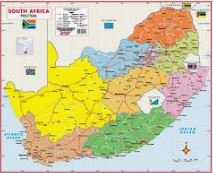Part 1: A history of race and rape in South Africa
Late in September a 20 year-old man was caught raping a 7 year-old girl in a restaurant toilet. It was an extraordinarily brazen act which has outraged most South Africans. What made the incident even more complicated was the fact that the alleged rapist is a white man and the victim a young black child. In a country with a history as racialised as South Africa's this was like a match to gasoline. Yet Black Land First and White Nation – the polar opposites of each other – both condemned the alleged rapist's behaviour with disgust. Their shared ability to do so points to an unexpected commonality, that is, a way of using rape to think about race, deeply rooted in South Africa’s history. This two-part article will retrace that past because it explains a great deal about why the rape at this Restaurant assumed the meanings it did.
1870, in the colony of Natal, is a good place to start this history. This is when “black peril” scares made their first documented appearance, with the last of these recorded in 1914 on the Witwatersrand. These panics typically grew out of the sensationalisation and exaggeration of occasional, single instances where black men raped white women.
Writing about the Witwatersrand panics Charles van Onselen suggested that they typically played out within periods marked by recession, political uncertainty and industrial action. These conditions affected households’ ability to pay their servants’ wages and, in a few instances, it would seem that actual rapes occurred where there had been a dispute over pay. In other cases there is some evidence that claims of rape were cynically manipulated in order to default on wage payments. More generally though, these distinctive economic conditions seemed to bring a range of inchoate anxieties and fears to the surface which found expression through these scares. But whatever their cause, they typically resulted in greater control of colonised men. Indeed, in 1921 Sol Plaatje noted that Lord Harcourt, the British Colonial Secretary, had justified the 1913 Natives Land Act as a means of preventing cases of “black peril”.
Sol Plaatjie also sought to bring attention to the “white peril,” or the hidden accounts of black women’s abuse and exploitation by white men. Trooper Peter Halket of Mashonaland, Olive Schreiner’s 1897 novel provides one of the earliest examples of a “white peril” narrative and offered a critique of British imperialism through her account of the rape and mass murder of black women and men. The gang rape of ‘Sana’ in 1977 by four white soldiers – Peter Faught, Petrus Liebenberg, Ivan Bernado and Brian van Zyl – is a rare instance of such cases going to trial. Adries de Wet, a state witness in their trial, testified to having overheard one the soldiers say to his companions that they were crossing the border into Botswana ‘to have sex with black women.’
Because such cases went largely unreported, fiction has provided the chief vehicle for exploring the impact of white men’s rape on black women’s lives. Lauretta Ngcobo, in her 1990 novel And They Didn’t Die, provides one such powerful account. The complexities and challenges of raising children conceived under such circumstances is also explored by And They Didn’t Die, as well as Farida Karodia’s Other Secrets.
Against this historical backdrop the rape, by a white man, of a young black girl takes on profound symbolic significance. Add to that the way we think about children as our future and Nicholas Ninow’s actions not only re-enacted a grievous racist past, but also assaulted the future and the hopes invested therein.
This is the arc of history that the rape evoked for Black Land First. White Nation drew on it too – but to argue that this rape by a white man was far outnumbered by “black peril” rapes. White Nation also drew on a slightly different history to explain the rapist, that of the paedophile - to be explored tomorrow.

To listen to the audio version of this article click on the play image.

Brought to you by @tts. If you find it useful please consider upvoting this reply.